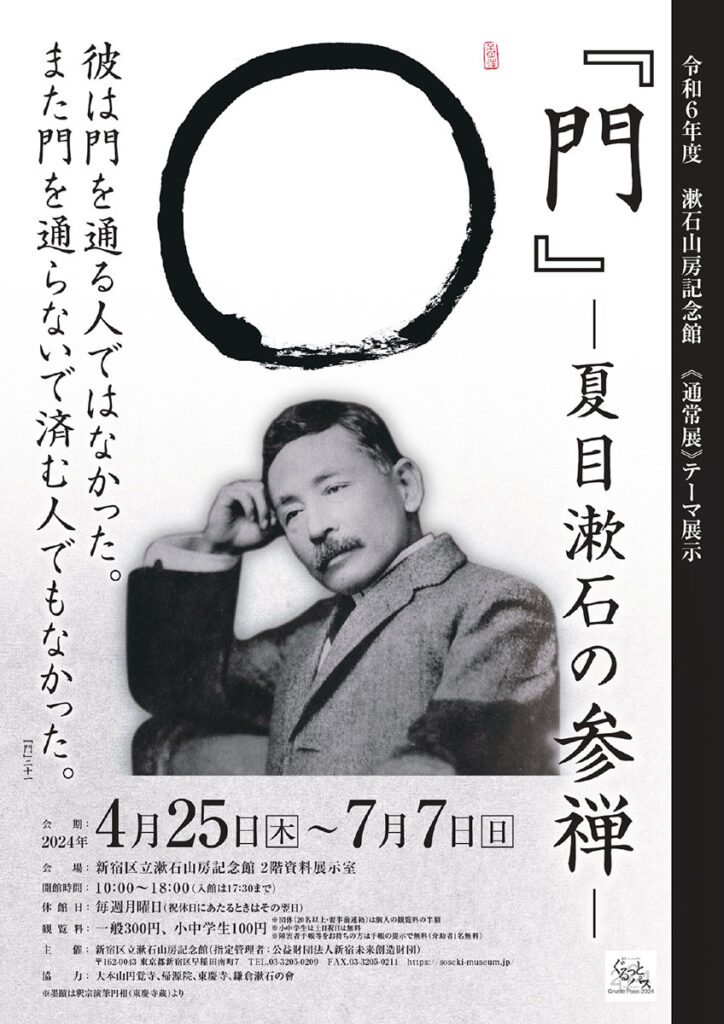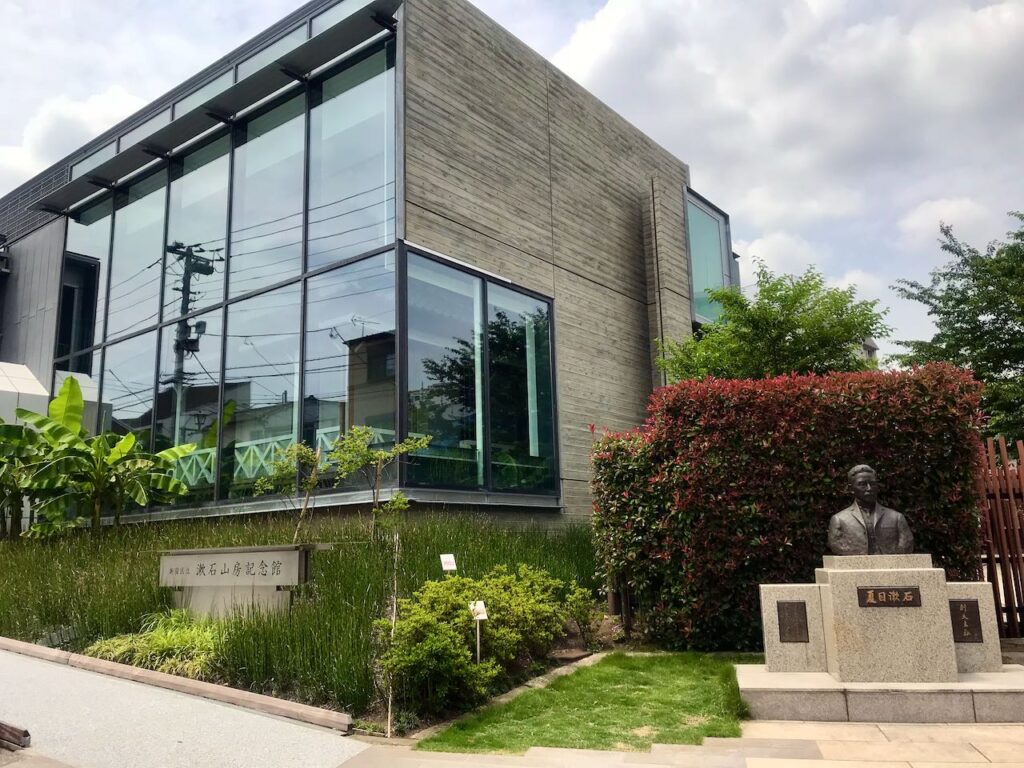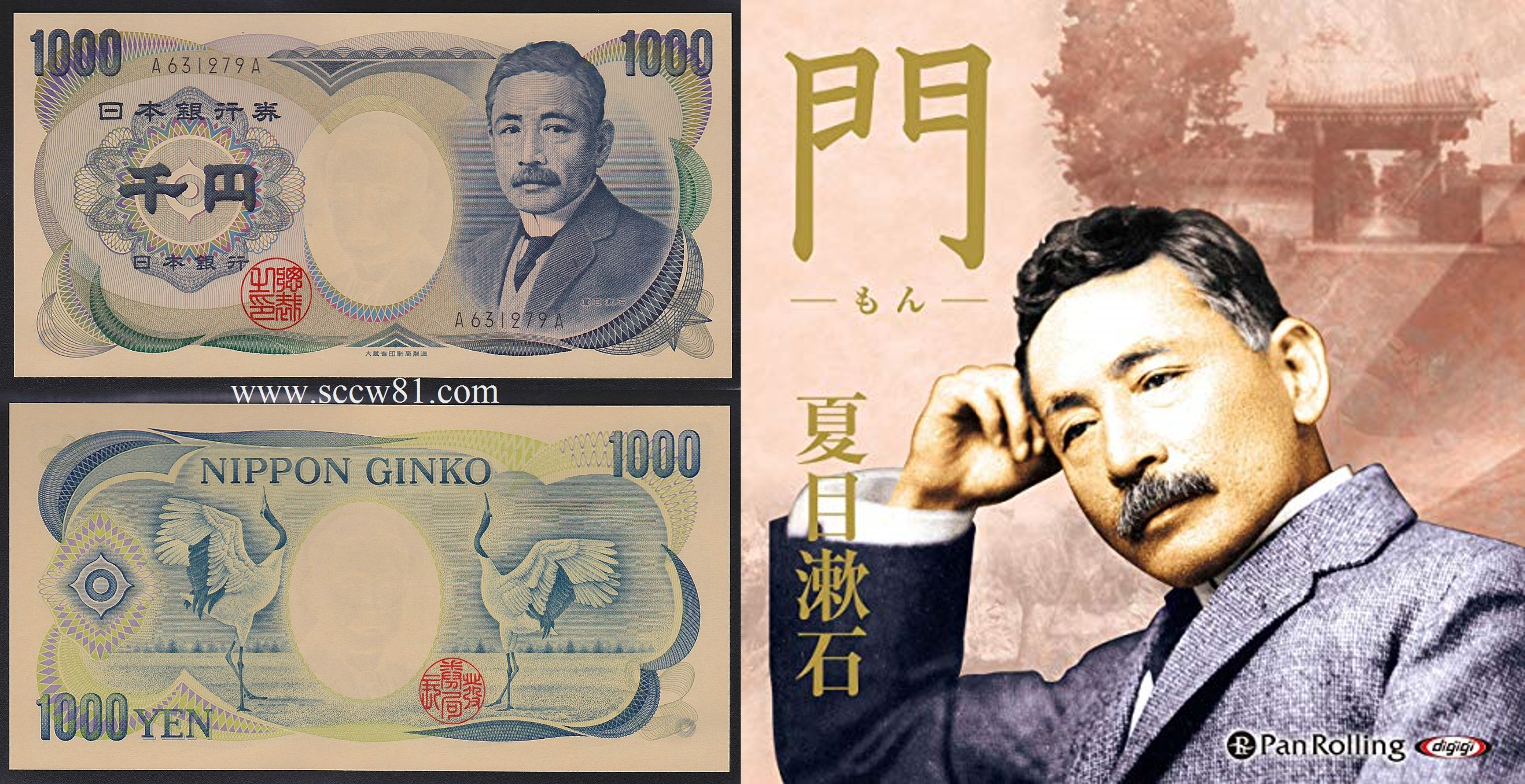After exiting Waseda Station, walk through a quiet residential area and down a gentle slope, and you will see a large modern building on your left. Part of the building is made of glass, and you can see from the outside that the interior is a reproduction of an old Japanese house.

This is a reproduction of the house where
Soseki Natsume, the master of Japanese literature, spent the last years of his
life. According to the designer’s comments, the house is a faithful
reproduction of its original location and orientation, and it is deeply moving
to think that the great writer, 100 years removed from his life, must have been
watching the people passing by on this slope from that very spot. When I first
visited this place, I was deeply moved by the image of Soseki sitting alone
while petting a cat.
The modern building that houses the Soseki
Memorial Museum is the Soseki Sanso Memorial Hall. The restored study, the
manuscripts in Soseki’s own handwriting, and his letters to his students make
it an irresistible space for Soseki fans. It is also the birthplace of Soseki’s
most beloved work, “The Gate,” which was published in the same year.
And now, coincidentally, a special exhibition is being held on the theme of
“The Gate. In this article, I would like to introduce the museum, which is
the only one in Japan built for Soseki research and propagation, as well as the
work “The Gate”.
Shinjuku Soseki Sanso Memorial Hall

The Shinjuku Soseki Sanso Memorial Museum was established by Shinjuku City, Tokyo, to commemorate the 150th anniversary of the birth of Soseki Natsume, and opened on September 24, 2017 (Heisei 29).
Soseki was born and raised in Shinjuku City, and also spent nine years of his life at “Soseki Sanso” in what is now Waseda Minamimachi, Shinjuku City, until his death in 1916. In 2011, the city took the opportunity of rebuilding and relocating the municipal housing complex to a new location, and the Soseki Park was designated as the “Soseki Park” by the city. In 2011, the ward decided to build Japan’s first full-scale Soseki Memorial Hall, a recreation of the former “Soseki Sanso” (Soseki’s cell house), on the same site as Soseki Park. The museum will house a large collection of Soseki’s literary works, as well as a permanent exhibition of various Soseki-related exhibits.
The exhibited materials include drafts of “Michikusa” and “Meiyo”, a postcard sent to Soseki’s disciple Toyo Matsune, “Gasan of Soseki Sensei” by the painter Seifu Tsuda, and many first editions of Soseki’s books.
Exhibition Rooms
In the regular exhibition, graphic panels and videos introduce the following themes: 1) Soseki Natsume and Shinjuku, 2) Soseki’s life, 3) the world of Soseki’s works, 4) people surrounding Soseki, 5) Soseki and haiku, and 6) Soseki and painting. Visitors can also experience a recreation of part of Soseki’s “Soseki Yamabo,” where Soseki lived, and experience the study, guest room, and veranda-style corridor where he used to create works and communicate with his students. In addition, drafts, letters, first editions, and other materials owned by Shinjuku City are also on display.
Introductory Exhibition [1F] (free of charge)
Graphic panels and videos introduce basic information on Soseki, including his relationship with Shinjuku, his life, his character, and his family.

Reproduction exhibition [1F] (surcharge)
The exhibition reproduces a part of “Soseki Sanso,” including the study, drawing room, and veranda-style corridor, and introduces the “Thursday Meeting” held weekly in the drawing room, the world of the essay “In the Glass Door” written in the study, and the efforts to reproduce “Soseki Sanso”. The reproductions made in the study were produced with the cooperation of the Kanagawa Museum of Modern Literature, and are based on original materials in the museum’s collection. The Western books on the shelves were made with the cooperation of the Tohoku University Library by photographing the spines of books in the library’s “Soseki Collection.

Reference Exhibition Room [2F] (fee required)
Graphic panels and videos are used to introduce Soseki and the world of his works, the people surrounding him (52 people), Soseki and haiku, Soseki and paintings, etc. In addition, drafts, letters, first editions, and other materials owned by Shinjuku City are on display.


Building and Surrounding Design

The design was based on the basic principle that the entire townscape is the memorial, not just the exhibits inside the so-called memorial hall. The textile that resembles a cloud hanging from the ceiling of the upper part of the cellar has a frottage taken from Soseki’s view of the cityscape of Waseda. Many plants from Soseki’s novels are planted in the garden. In addition to enjoying the recreation of Sansho and the permanent and special exhibitions in the exhibition room, visitors can also experience many other aspects of Soseki.
Masayuki Irie, representative of Form Design Ichio (professor emeritus at Waseda University), said, “The mountain cell is the cornerstone of this building, and we thought that the relationship with the garden and the slope was important. We wanted the garden and slope to be visible from the cell, just as Soseki once saw them, and for people passing by on the slope to see the cell in the same light as before his death,” he said.
The gentle slope in front of the house was familiar to Soseki, and was nicknamed “Dara Dara Slope.

The neighborhood is dotted with places that already existed during Soseki’s lifetime, including Sosanji Temple. In addition, Soseki’s novels, in which he used language to polish the mundane into a work of fiction through detailed observation of everyday scenes, often describe the Waseda area, Kagurazaka, Edogawabashi, and other scenery. In this context, many traces of Soseki can be found in the vicinity of the museum.
Regular Exhibition: “The Gate” – Soseki Natsume’s Zen meditation

In the spring of 1914, Soseki began to have a close relationship with two young ascetic monks, and just as he was deepening his interest in Zen, Soseki passed away,
Soseki died just as he was deepening his interest in Zen. One of these young Unsui, coincidentally, became the abbot of Engakuji’s pagoda, Kigen’in, where Soseki stayed during his visit to Zen in 1894, and his letters to Soseki have been handed down to this day. This exhibition commemorates the 130th anniversary of Soseki’s Zen meditation, and is based on materials related to Shaku Sōen, who taught Soseki Zen, descriptions of Zen in Soseki’s works, and letters he wrote to Unsui,
The exhibition introduces the relationship between Soseki and Zen.
Soseki visited Engakuji Temple in Kamakura from the end of 1894 to the beginning of the following year. The Zen flavor can be found in many of Soseki’s works, but his life during this period and his experience of returning to Tokyo without enlightenment are best reflected in his novel “The Gate,” published in 1910 in the Tokyo and Osaka Asahi Shimbuns.
The “Gate”.

Mon” is a full-length novel by Soseki Natsume, first serialized in the Asahi Shimbun in 1910 and published by Shunyodo in January of the following year. It is the last novel in the trilogy, following “Sanshiro” and “Sorekara”. It depicts the story of Sosuke, who betrayed his best friend Yasui and married his wife, Migome, and seeks salvation out of guilt.
The story is as follows
———- —
Sosuke has acquired Mome, the wife of his former best friend Yasui, but because of his sin, he is forced to live in seclusion. He is not concerned about his father’s legacy regarding his younger brother Koroku, so he takes Koroku in and lives with him. However, due to living with his younger brother, who had a lot of hardships, Gome fell ill in bed. Although nothing serious happens, Yasui’s news eventually reaches him, and he hears that he is to visit his landlord, Sakai. Sosuke went to Kamakura to seek salvation, but in the end he was unable to attain enlightenment and returned home. Yasui had already returned to Manchuria, and Koroku had been assigned to be Sakai’s student. Gome is happy that spring has come, but Sosuke replies that winter will soon arrive.
———- —
The story is not about any major incident from beginning to end. Rather, this story is a sequel to a major incident in which Soseki cuckolds his best friend’s wife. Adultery is a frequent theme in Soseki’s literature, probably because, unlike today, adultery in those days was a big deal involving a village, and the social and emotional impact on the person in the middle of the affair was enormous (someone once described this as “the internalization of moral guilt”). At the same time, such adversity would have purified the quality of their love, making it an inevitable theme for a romance novel. Nevertheless, this story begins at a point in time when the series of the affair is over, and the love interest and the people around him have calmed down to a certain extent. Herein lies the real appeal of Soseki’s literature.
As in movies, manga, and novels, real life does not always unfold in dramatic fashion. Even if something dramatic happens, it is never neatly settled. In a fictional story, the curtain can close on its own before the characters have even processed their inner lives, but in reality, it is not so easy. There is no reality or lesson to be found in a contrived, artificial plot that comes to a grand conclusion after many ups and downs. Real emotions are always continuous, and there is no end to them. That is why Sosuke in “The Gate” finally chooses to become a priest long after the affair. The guilt that he had been suppressing is unleashed when the possibility of Yasui’s appearance is suggested.
As mentioned above, Sosuke has internalized the laws, ethics, and morals of the world to such an extent that he is unable to distinguish between the norms of the world and his own feelings. For such a person,Religious teachings cannot bring any relief. This is why Soseki expressed the feelings of Sosuke, who was suffering from this “disease of modernity,” in the following famous sentence, which is synonymous with this novel.
He was not a man who would pass through the gate. Nor was he a person who did not have to pass through the gate. In short, he was an unfortunate man who had to cower under the gate and wait for the sun to set.
As mentioned above, the story ends with the successful avoidance of the encounter with the best friend. Although the story has a happy ending, it does not give the reader an exhilarating reading experience. We, who have been bombarded with “emotional continuity,” can’t help but imagine Sosuke’s unchanged, depressing life afterwards, even after closing the book. What does this suffocating reality bring to us? Will it be a lesson for tomorrow, the attainment of an existence yet to be discovered, a philosophical quest, or will we still, like Sosuke, seek religion?
It is fortunate that there is a place like this to answer these questions. Information is below.
Normal Exhibition: “The Gate” – Soseki Natsume’s Zen meditation
Period: April 25, 2024 – July 7, 2024
Hours: 10:00 a.m. – 6:00 p.m. (Admission until 5:30 p.m.)
Venue: Soseki Sanso Memorial Hall, 2nd floor
Closed Mondays (or the following weekday if it falls on a national holiday)
Admission 300 yen for adults, 100 yen for elementary and junior high school students
Groups of 20 or more people (advance notice required) receive half the price of individual admission.
Free admission for elementary and junior high school students on Saturdays, Sundays, and national holidays.
Free admission for those with a disability certificate (one caregiver free of charge) upon presentation of the certificate.
Free admission for Members Club members upon presentation of membership card.
・Gallery Talk
May 12 (Sun) and June 16 (Sun), 2:00-2:20 p.m. each day
Venue: Soseki Sanso Memorial Hall, B1F Lecture Room
No registration required, free of charge. Please come directly to the B1F lecture room.

★The writer of this blog: Ricky★
Leave it to us when it comes to cultural matters! Ricky, a Japanese culture evangelist, will turn you into a Japan geek!
Source
Shinjuku Soseki Sanso Memorial Hall
Kosuke Wakuda Architects & Engineers, Inc.
Wikipedia




